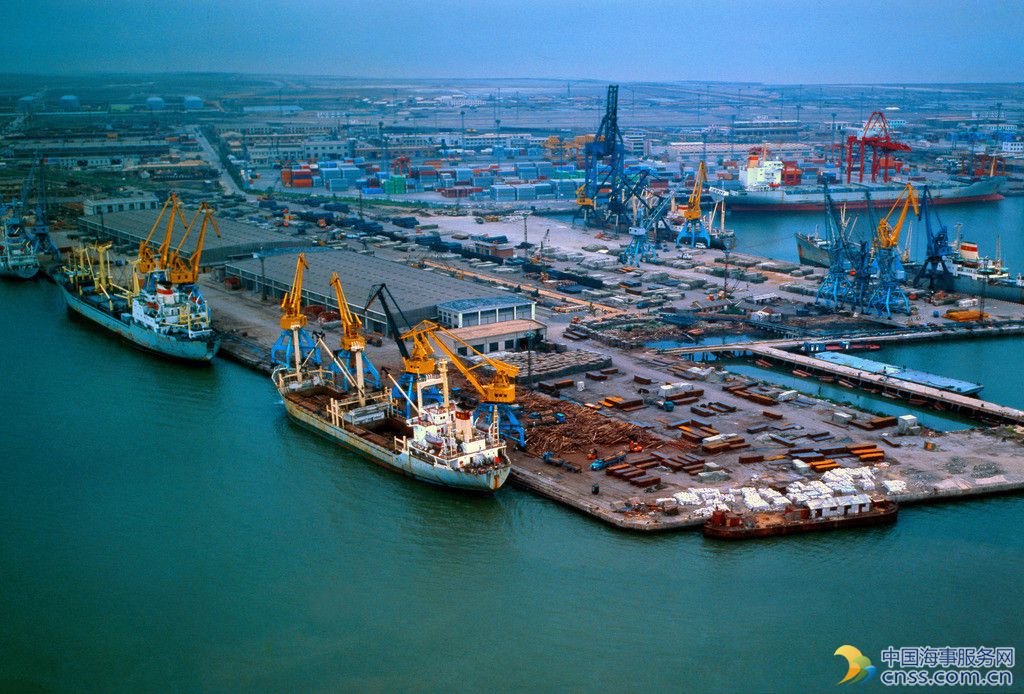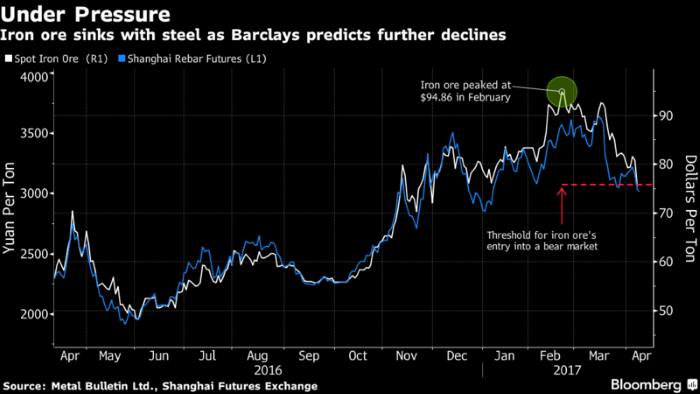Iron Ore Slumps Into Bear Market as Barclays Sees Further Losses

Iron ore’s descent into bear-market territory may herald further weakness, with Barclays Plc pinning the blame for the slide on lower steel demand in China driving a shift from mills toward lower-quality ore and raising the prospect of a drop into the $50s.
Ore with 62 percent content in Qingdao fell 1 percent to $74.71 a dry ton on Monday, according to Metal Bulletin Ltd., following a 6.8 percent drop on Friday that pushed the commodity into a bear market from a February peak. Earlier in Asia, futures in Dalian sank to the lowest since November, and those in Singapore traded below $72.
Iron ore is in retreat after a procession of negative outlooks, with Barclays among banks saying that gains were unsustainable, along with Australia’s central bank and even some mining companies. There’s concern that curbs in China may hurt steel consumption in the top user, as well as forecasts that a further expansion in mine supplies from Brazil, Australia and China will undermine prices. Steel in China has also sagged.
“The weakness in prices was driven by a slackening in end-use steel demand,” Barclays analyst Dane Davis told Bloomberg in an email. “When that occurred, steel producers switched to lower-quality iron ores, which were in abundance,” said Davis, who’s been bearish on the outlook for months.

Miners’ climbed in London even as the SGX AsiaClear contract fell for a third day. BHP Billiton Ltd. — targeted for an overhaul by Paul Elliott Singer’s Elliott Management Corp. — rose 4.6 percent, while Rio Tinto Group added 1.1 percent. In Sydney, Fortescue Metals Group Ltd. pared losses to trade little changed. BHP has cautioned in recent weeks that prices may retrace.
Axiom Capital Management Inc., a consistent bear on iron ore, said in a report on Monday that “the timing is ripe” for bets on lower prices, citing prospects for increased mine supplies and tentative signs that record stockpiles at China’s ports may be starting to be sold off. After peaking at 132.5 million tons on March 24, the holdings have posted the first back-to-back drop since September, according to Shanghai Steelhome E-Commerce Co.
Australia’s government preceded the latest steep drop with its own warning. “Growing supply, primarily from Australia and Brazil, is expected to steadily outpace demand growth over the rest of 2017,” the Department of Industry, Innovation and Science said in a quarterly report released on Friday. Ore may slump to $55 in the final quarter, it said.
China has been tightening restrictions on its real-estate market in recent months after prices soared, clouding the outlook for construction steel, including reinforcement bar. Last month, the central bank asked banks in Beijing to scrutinize home loans to newly divorced couples and funding sources for borrowers, adding to other curbs.
‘Begun to Tighten’
Still, while prices have dropped, they remain well above levels seen 12 months ago. Iron ore surged more than 80 percent last year — in a rally that caught out many bears — as steel production and demand in China proved more resilient that expected.
“While some may label this a bear market, the reality is that prices are still 33 percent higher than they were this time last year and well above any levels seen since 2014,” Australia & New Zealand Banking Group Ltd. said in a note on Monday. “The macro backdrop for iron ore is that after maintaining very loose monetary policy through 2014 and 2015, China has begun to tighten.”
Iron ore’s losses have also come as investors reassessed the ability of President Donald Trump’s administration to deliver on plans to overhaul U.S. infrastructure. Initial enthusiasm about the drive in the top economy had helped iron ore to gain between November and February.
Among recent bearish forecasts, Reserve Bank of Australia Governor Philip Lowe said in February commodity prices were going to fall again, including iron ore. Capital Economics Ltd. said in March there’s some doubt about China’s demand, and predicted a retreat to $45 by year-end.
Barclays’s Davis told Bloomberg in an interview in January that prices weren’t sustainable given the outlook for a rising supply and plateauing or weaker demand. At the weekend, he said of the recent losses: “Please note, we have been calling for this for a while.”
Source: Bloomberg
HEADLINES
- Do shipping markets want Biden or Trump for the win?
- All 18 crew safe after fire on Japanese-owned tanker off Singapore
- Singapore launching $44m co-investment initiative for maritime tech start-ups
- Cosco debuts Global Shipping Industry Chain Cooperation Initiative
- US warns of more shipping sanctions
- China continues seaport consolidation as Dalian offer goes unconditional